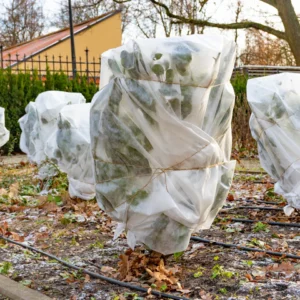Humans have been growing figs for thousands of years and it’s easy to see why. Fig fruits are delicious and supple when eaten fresh, preferably sun-warmed right off the tree. They can be dried and used in all kinds of baked goods and desserts. With a little bit of attentiveness, any gardener can be successful growing figs in Utah.
Are Figs cold hardy?
Edible figs (fruit of the species Ficus carica) are native to the Mediterranean and Western Asia, where they thrive in warm climates with dry summers and mild winters. Through cultivation over many centuries, intrepid fig growers have produced some reliably cold-hardy varieties. These varieties can withstand near freezing temperatures, and with some protection, even colder temperatures.
Ideal Growing Conditions for Figs
Sunlight: Figs prefer full sun, and can even tolerate hot, southern exposures and reflected heat. Too much shade, and your fig may not produce fruits.
Watering: Though figs can adapt to drought conditions after getting established, they prefer regular watering and consistently moist soil conditions during the growing season. Mulching around the base of the plant (as long as it’s not touching the trunk) can help keep moisture in the soil for longer. Occasional deep watering, especially through the Summer, will keep a fig happy.
Soil & Fertilizing: Figs aren’t too fussy about their soil pH, meaning that they can grow just fine in Utah’s alkaline soils. But they do their best in a loamy, well-draining soil mix with plenty of organic matter. Amend your soil with a product with well-composted organic material like Harvest Supreme or Soil Pep. Fig will appreciate a periodic Fruit Tree fertilizer, though excessive fertilizing will cause fruits to not ripen properly.
Secondary Water: Figs are moderately tolerant of secondary water that contains salts, though we recommended periodically flushing with culinary water to prevent excess salt build up.
Preparing Figs for Winter
Fig trees in Northern Utah need some protection to survive freezing temperatures. There are many ways to do this, and people have come up with all kinds of devices over the years to protect their figs. Think of winter protection in two ways: Insulating the root mass of your tree and protecting the trunk and branches. Mulch over the root mass of the plant to insulate the roots, and water monthly through the Winter to ensure they don’t dry out. You can also drape plastic sheeting over the branches to trap radiant heat around the tree. If your fig has a tall, single trunk, wrap with tree trunk wrap to protect from sun scald and freezing and thawing.

Growing Figs in Containers
One way to protect fig trees through harsh winters is by growing them in containers and taking them inside. Figs can easily grow in containers, making them a great option for small spaces and patios. When temperatures and leaves drop, you can either bring the plant inside your home or garage near a sunny window.
Do Figs need to be pollinated?
While wild figs evolved to be pollinated by specialized fig wasps, commonly cultivated varieties you’ll find in nurseries are self-pollinating. That means that you don’t need to have two different varieties of figs in order to get fruit.
FIG FACT: A fig fruit is a Syconium, a type of multiple and accessory fruit developed from numerous achenes and flowers enveloped in a fleshy, hollow receptacle. Essentially, the insides of a fig are filled with thousands of tiny fruits!

How big do Figs get?
In ideal conditions figs can reach heights of 15’ to 30’ tall with a spread of 20’ or more. In temperate climates with cold winters, figs will never get to be quite as large as this. Even with winter protection, figs may experience branch dieback when exposed to freezing temperatures. The yearly cycle of damage, dieback and pruning means that the plants themselves tend to be more multi-stemmed and bushy, never really getting to full tree size. The good news is that figs can regrow after moderate damage and will produce fruit from each year’s new growth.
Harvesting Figs
What is a Breba Crop? A fig tree’s main crop is produced in late Summer to Fall on that year’s new growth. Some fig varieties may produce an earlier, smaller crop on the previous year’s growth. This is called a Breba or Brebber crop. Figs in colder climates typically don’t produce these early crops, as late frosts often kill off any developing fruit.
Cold Hardy Fig Varieties for Utah
When selecting a fig variety for your garden, pay close attention to the USDA Hardiness Zone. Most figs available in your local nursery will be either Zone 6 or 7.
Violette de Bordeaux
Zone: 6
A Mission-style variety originating in France. Fruits are jet black to purple with dark red centers and a rich flavor.
Chicago Hardy
Zone: 6
An especially hardy variety that produces small brown-to-purple colored figs with a sweet, strawberry jam-like center.
Desert King
Zone: 6
A highly productive variety that performs well in temperate climates. Fruit is yellow-green when ripe with sweet, strawberry-colored flesh.
Figs for Southern Utah
Many areas of Southern Utah, such as St. George, experience milder winters and figs are able to grow larger without winter protection.
Figs for Park City
Higher elevations of Utah experience colder and more sustained winter temperatures than other areas. Cold-hardy figs may not be suited for these areas.

